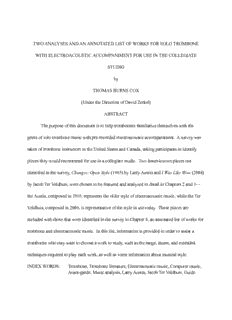
two analyses and an annotated list of works for solo trombone with electroacoustic accompaniment ... PDF
Preview two analyses and an annotated list of works for solo trombone with electroacoustic accompaniment ...
TWO ANALYSES AND AN ANNOTATED LIST OF WORKS FOR SOLO TROMBONE WITH ELECTROACOUSTIC ACCOMPANIMENT FOR USE IN THE COLLEGIATE STUDIO by THOMAS BURNS COX (Under the Direction of David Zerkel) ABSTRACT The purpose of this document is to help trombonists familiarize themselves with the genre of solo trombone music with pre-recorded electroacoustic accompaniment. A survey was taken of trombone instructors in the United States and Canada, asking participants to identify pieces they would recommend for use in a collegiate studio. Two lesser-known pieces not identified in the survey, Changes: Open Style (1965) by Larry Austin and I Was Like Wow (2004) by Jacob Ter Veldhuis, were chosen to be featured and analyzed in detail in Chapters 2 and 3— the Austin, composed in 1965, represents the older style of electroacoustic music, while the Ter Veldhuis, composed in 2006, is representative of the style in use today. These pieces are included with those that were identified in the survey in Chapter 4, an annotated list of works for trombone and electroacoustic music. In this list, information is provided in order to assist a trombonist who may want to choose a work to study, such as the range, mutes, and extended techniques required to play each work, as well as some information about musical style. INDEX WORDS: Trombone, Trombone literature, Electroacoustic music, Computer music, Avant-garde, Music analysis, Larry Austin, Jacob Ter Veldhuis, Guide TWO ANALYSES AND AN ANNOTATED LIST OF WORKS FOR SOLO TROMBONE WITH ELECTROACOUSTIC ACCOMPANIMENT FOR USE IN THE COLLEGIATE STUDIO by THOMAS BURNS COX B.S., The University of Alabama, 2005 M.M.Ed., The University of Georgia, 2007 A Document Submitted to the Graduate Faculty of The University of Georgia in Partial Fulfillment of the Requirements for the Degree DOCTOR OF MUSICAL ARTS ATHENS, GEORGIA 2011 © 2011 Thomas Burns Cox All Rights Reserved TWO ANALYSES AND AN ANNOTATED LIST OF WORKS FOR SOLO TROMBONE WITH ELECTROACOUSTIC ACCOMPANIMENT FOR USE IN THE COLLEGIATE STUDIO by THOMAS BURNS COX Major Professor: David Zerkel Committee: Joshua Bynum Adrian Childs Electronic Version Approved: Maureen Grasso Dean of the Graduate School The University of Georgia May 2011 Dedication This document is dedicated to my son, Nathan Christopher Cox, born on December 14, 2010. iv Acknowledgements There are many people who deserve a share of the credit for making this document possible. I would like to thank Amanda and Nate for their patience as I worked toward achievement of this academic goal. Thanks also go to my mother, Fae Kelley, father, Bill Cox, and stepfather, Dan Kelley, as well as my mother- and father-in-law, Jane and Daron Green, and my brother-in-law, Chris Green, for all of their help and support in my musical endeavors over the years. My major professor, David Zerkel, deserves special recognition for agreeing to take over that post for the last few years of my studies. I would also like to recognize my committee members, Joshua Bynum and Adrian Childs. In addition, I would like to thank several others whose service on my committee was invaluable, but who are no longer part of it due to retirement or rules changes: Philip Jameson, Edward Sandor, Jean Martin-Williams, John Lynch, and David Schiller. Other UGA faculty members who deserve recognition for their contributions to my studies and support of my assistantship duties over the years include Roger Vogel, Steve Valdez, Mary Leglar, and Michael Siciliano. I am also deeply indebted to Fred Mills, whose encouragement was invaluable and whose untimely passing in 2009 shook the Hugh Hodgson School of Music to its core. I would also like to thank all of my former teachers, Mike Becker, Philip Jameson, Dan Drill, and Scott McBride, for their invaluable contributions to my musical development. Others who deserve recognition for their support in my musical endeavors over the years have included v the late Gerald Welker, Harry Price, Ken McGuire, Pam Gordon, Mike Dunn, Robert Carter, Don Hall, the late Judy Latz, and Jack Miller. Finally, I am compelled to thank my friend Phillip Bloomer for programming Scott Wyatt’s Three for One for tuba and tape on his 2009 Master’s recital, introducing me to the world of instrumental solos with electroacoustic accompaniment and providing the initial inspiration for the topic of this document. vi Table of Contents Page Acknowledgements......................................................................................................................... v List of Tables.................................................................................................................................. ix List of FIgures................................................................................................................................. x Chapter 1 Introduction................................................................................................................... 1 Related Literature..................................................................................................... 5 Need for the Study................................................................................................. 10 Methodology.......................................................................................................... 11 Delimitations.......................................................................................................... 15 Organization of the Study...................................................................................... 15 Range Designations............................................................................................... 16 Definitions of Terms.............................................................................................. 16 2 Analysis of Changes: Open Style by Larry Austin..................................................... 19 Section I................................................................................................................. 23 Section II................................................................................................................ 25 Section III............................................................................................................... 27 Section IV............................................................................................................... 29 Section V................................................................................................................ 31 Section VI.............................................................................................................. 34 vii Section VII............................................................................................................. 36 Conclusions............................................................................................................ 38 Pedagogical Considerations................................................................................... 40 3 Analysis of I Was Like Wow by Jacob Ter Veldhuis.................................................... 42 Section I................................................................................................................. 45 Section II................................................................................................................ 47 Section III............................................................................................................... 48 Section IV............................................................................................................... 50 Smaller Formal Divisions...................................................................................... 52 Conclusions............................................................................................................ 55 Pedagogical Considerations................................................................................... 58 4 Annotated List of Works Recommended by Survey Participants............................... 60 5 Conclusions and Recommendations for Further Study............................................... 77 Conclusions............................................................................................................ 77 Recommendations for Further Study..................................................................... 82 Bibliography/Discography............................................................................................................ 84 Books and Articles............................................................................................................. 84 Scores................................................................................................................................. 89 Recordings......................................................................................................................... 90 Appendix: Full Results of Survey................................................................................................. 92 viii List of Tables Page Table 2.1: Recurring motives in Changes: Open Style................................................................. 21 Table 2.2: Major divisions in Changes: Open Style..................................................................... 23 Table 3.1: Major divisions in I Was Like Wow.............................................................................. 45 Table 3.2: Minor divisions of I Was Like Wow and their characteristics...................................... 54 ix
Description: